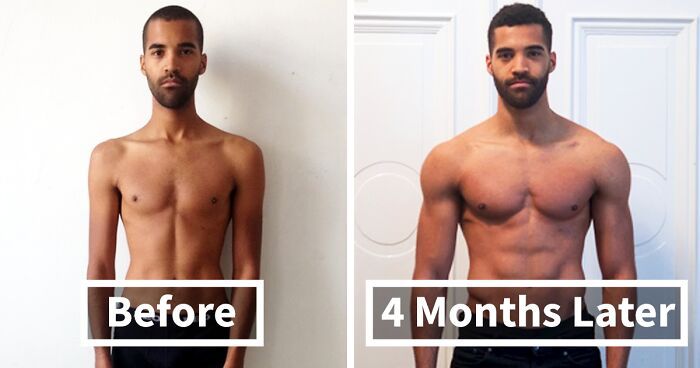
There are 3 main things that affect muscle growth:
- food
- strength / resistance training
- rest
To grow muscle, you need to
- do strength training to break down muscle
- have a moderate calorie surplus
- have sufficient protein consumption (1 gram of protein per pound of body weight)
- rest to build muscle
If you have a calorie deficit, your body will expend more energy resulting in weight loss in the form of BOTH fat and muscle loss.
If you have an excessive calorie surplus, you will GAIN weight, and grow some muscle but also gain a lot of fat.
You build muscle when the amount of protein synthesized into muscle during rest is greater than the amount of muscle protein breakdown during strength training. Without sufficient protein, you will just gain fat and little muscle.
Food
Both creatine and whey protein powder have been shown to increase muscle mass when taken in combination with resistance exercise.
Creatine increases exercise capacity during high-intensity exercise. This leads to improved recovery and adaptations such as increased muscle mass.
Meanwhile, ingesting whey protein in combination with exercise provides your body with a high-quality source of protein, enhancing muscle protein synthesis and leading to increased muscle gains over time.
While both creatine and whey protein promote muscle gain, they differ in the ways they work. Creatine increases strength and muscle mass by increasing exercise capacity, whereas whey protein does so by stimulating increased muscle protein synthesis.
Protein
Muscles are made out of protein, among other things. So, you’re going to need to consume enough protein to build muscle. You should target 1 gram of protein per pound of body weight. For example, I currently weigh 178 lbs, so I should consume 178 grams of protein. Here are some protein-rich foods.
| Food | Quantity | Protein (g) | Calories | Protein / Calorie Ratio |
|---|---|---|---|---|
| Eggs | 1 large | 6 | 78 | 11% |
| Egg White | 1 large | 4 | 18 | 22% |
| Almonds | 1 ounce | 6 | 164 | 3.6% |
| Chicken Breast | 1 roasted w/o skin | 53 | 284 | 18% |
| Oats | 1 cup | 11 | 307 | 3.5% |
| Cottage Cheese | 1 cup | 28 | 163 | 17% |
| Greek Yogurt | 6 ounces | 17 | 100 | 17% |
| Regular Milk | 1 cup | 8 | 149 | 16% |
| Soy Milk | 1 cup | 6.3 | 105 | 6% |
| Broccoli | 1 cup chopped | 3 | 31 | 9.6% |
| Lean Beef | 3 ounces | 25 | 186 | 13% |
| Tuna | 1 can (142 grams) | 27 | 128 | 21% |
| Quinoa | 1 cup cooked | 8 | 222 | 3.6% |
| Whey protein concentrate supplement | 1 scoop (33 g) | 25 | 130 | 19% |
| Whey protein isolate supplement | 1 scoop (33 g) | 30 | 130 | 23% |
| Lentils | 1 cup boiled | 18 | 230 | 8% |
| Ezekiel Bread | 1 slice | 4 | 80 | 5% |
| Pumpkin Seeds | 1 ounce | 9 | 158 | 5.6% |
| Turkey Breast | 3 ounces | 26 | 125 | 20% |
| Shrimp | 3 ounces | 20 | 84 | 24% |
| Brussel Sprouts | 1/2 cup | 2 | 28 | 7% |
| Peanuts | 1 ounce | 7 | 161 | 4.3% |
Other protein-rich foods
Pistachios, cashews, parmesan cheese, swiss cheese, mozzarella cheese, cheddar cheese, regular full-fat yogurt, kefir, soybeans, kidney beans, chickpeas, flax seeds, sunflower seeds, chia seeds.
Consuming a lot of protein without supplements can be difficult because you might feel full before you’ve reached your target daily intake. Also, it can be expensive. For that reason, most bodybuilders take protein supplements. When choosing a protein supplement, it’s important to stay away from ones with a lot of added sugar. The most popular protein supplement is whey protein. To be safe, opt for pure whey protein. I personally get the unflavored Nutricost Whey Protein Concentrate. It contains only one ingredient: Whey protein concentrate. 1 scoop contains 25 g of protein and 130 calories.

You can also buy whey protein isolate, which has 90 – 95% protein compared to whey protein concentrate, which has 60 – 80% protein. Source
Creatine
Creatine monohydrate is the best-studied and most effective form of this supplement. There are 2 dosing regimens:
Option 1
- Loading phase: Take 20-25 grams split into 4 or 5 equal doses over 5-7 days.
- Maintenance phase: Then, take 3-5 grams per day to maintain your muscle stores of the compound.
Option 2
Skip the loading phase and start the maintenance phase.
Both options are effective. The first option will allow you to experience the benefits 4x faster. Source
I personally take unflavored Nutricost Creatine Monohydrate.
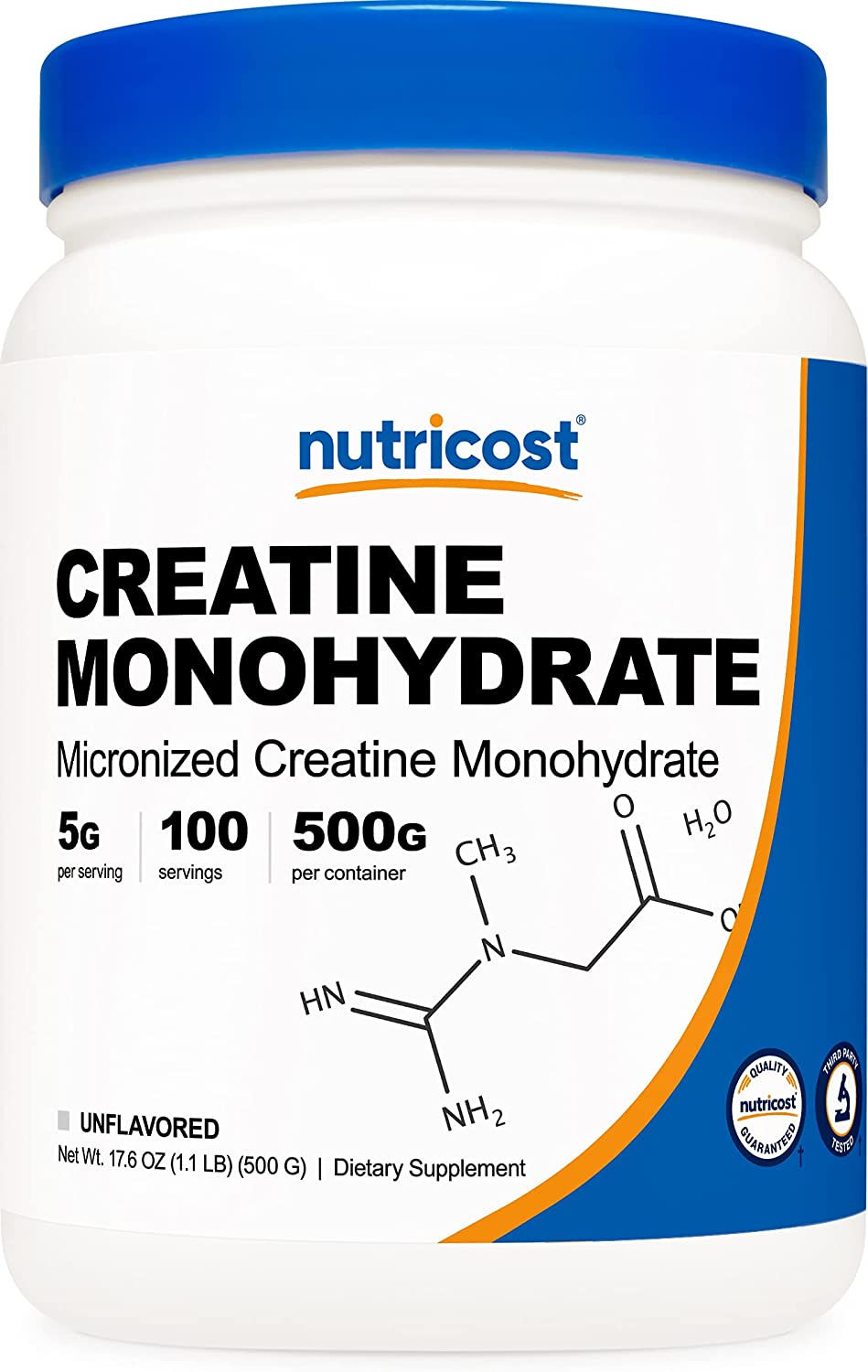
Other Foods
Now, don’t go consuming nothing but protein shakes. They are meant to be supplements and not food substitutes. You can eat whatever else you want, but generally, you should avoid processed foods and foods with lots of added sugar. I have personally found the Keto diet (very low-carb diet) to be one of the best, if not the best, diets. I was able to lose 20 lbs following the Keto diet. It’s not just good for losing weight, but it’s also good for overall healthy eating.
Calories
While you can build muscle in a calorie deficit (losing weight), it will be quicker to build muscle by having a moderate calorie surplus. In order to determine how many calories is “moderate”, you first need to know your maintenance calories – the number of calories to consume each day to neither lose nor gain weight.
Maintenance Calories
Your maintenance calories is the number of calories you consume and burn each day to neither lose nor gain weight. Use the calorie calculator from the Mayo Clinic to determine your maintenance calories. It uses the Mifflin-St. Jeor equation, which pros consider the gold standard.

Slight Calorie Deficit to Lose Weight Without Losing Muscle
On days you don’t lift weights, you want to lose fat. You can do this by counting calories consumed and, if you are doing cardio exercises (treadmill, etc), subtracting calories burned such that your net calorie deficit is 5-10% of your maintenance calories. In my case, that would be 2200 – 10% = 1980 calories. You don’t want a huge calorie deficit because then you’ll lose fat and muscle.
Moderate Calorie Surplus Gain Muscle
On days that you lift weights to build muscle, depending on how much muscle you want to put on and how quickly you want to gain it, add 5% to 15% to your maintenance calories. In my case, that would be 2200 + 15% = 2530 calories.
Example Weekly Schedule
| DAY | ACTIVITY | CALORIES |
|---|---|---|
| Monday | Rest | Calorie Deficit |
| Tuesday | Strength Training | Calorie Surplus, Extra Protein |
| Wednesday | Cardio | Calorie Deficit |
| Thursday | Rest | Calorie Deficit |
| Friday | Strength Training | Calorie Surplus, Extra Protein |
| Saturday | Cardio | Calorie Deficit |
| Sunday | Strength Training | Calorie Surplus, Extra Protein |
On calorie-surplus days, your body needs the extra calories above your maintenance calories to build new muscle while you sleep.
Example Meal Plan
Here’s my daily meal plan.
Breakfast
- 4 eggs in a bowl microwaved for 2 minutes
- 1 cup of espresso coffee with frothed milk, 1/4 teaspoon of Truvia sugar substitute (erithrytol + Stevia extra), and cinnamon

Lunch
Protein shake containing
- 1x 5.3oz of Ratio Keto Yogurt (15 g protein, 200 calories)
- 1 scoop of Nutricost Protein Concentrate (25 g protein, 130 calories) or protein isolate (30 g protein, 130 calories)
- 1 scoop (5 g) of Nutricost Creatine Monohydrate or
- 1/2 handful of walnuts
- 1 tbsp of chia seeds (2 g protein, 58 calories)
- 1 tbsp of ground flax seeds (1.6 g protein, 46 calories)
- 1/2 tsp of Matcha powder
- 1 pack of frozen Acai (1 g protein, 70 calories) or 1 tbsp of Acai powder
- 1/2 cup of unsweetened Soy milk (3.5 g protein, 40 calories)

Dinner
5 air-fried skinless chicken legs (60 g protein, 380 calories) with one Anaheim pepper

Post-Dinner Drink
Another protein smoothie, but substitute the Acai with 3 or 4 frozen strawberries
Post-Workout Drink
Chocolate-flavored Premier 30g Protein Drink (30 g protein, 160 calories)
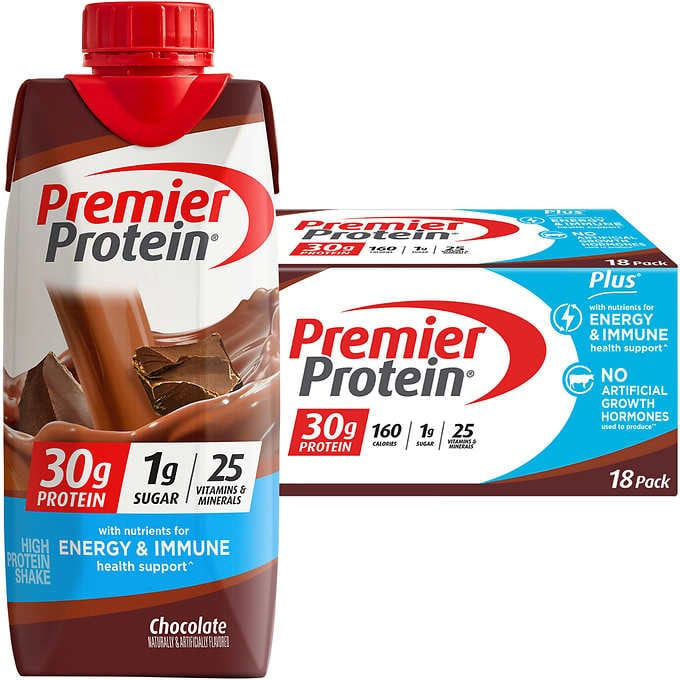
Total Daily Protein and Calorie Consumption
| Food | Quantity | Protein (gr) | Calories |
|---|---|---|---|
| Eggs | 4 | 24 | 300 |
| Protein shake | 1 | 48 | 544 |
| Chicken drumsticks | 5 | 60 | 380 |
| Protein shake | 1 | 48 | 544 |
| Protein drink | 1 | 30 | 160 |
| Snacks (nuts) | ? | ||
| Total | 210 | 1928 |
Without eating snacks, my total daily calorie intake is 1928.
Strength / Resistance Training
Muscle size increases when a person continually challenges the muscles to deal with higher levels of resistance or weight. This process is known as muscle hypertrophy.
Muscle hypertrophy occurs when the fibers of the muscles sustain damage or injury. The body repairs damaged fibers by fusing them, which increases the mass and size of the muscles. This increase, however, does not happen while you actually lift the weights. Instead, it occurs while you rest.
You need to be consistent and lift progressively heavier weights. To do this, you should keep track of your efforts. Personally, I log my workouts using the free version of the FitNotes app.
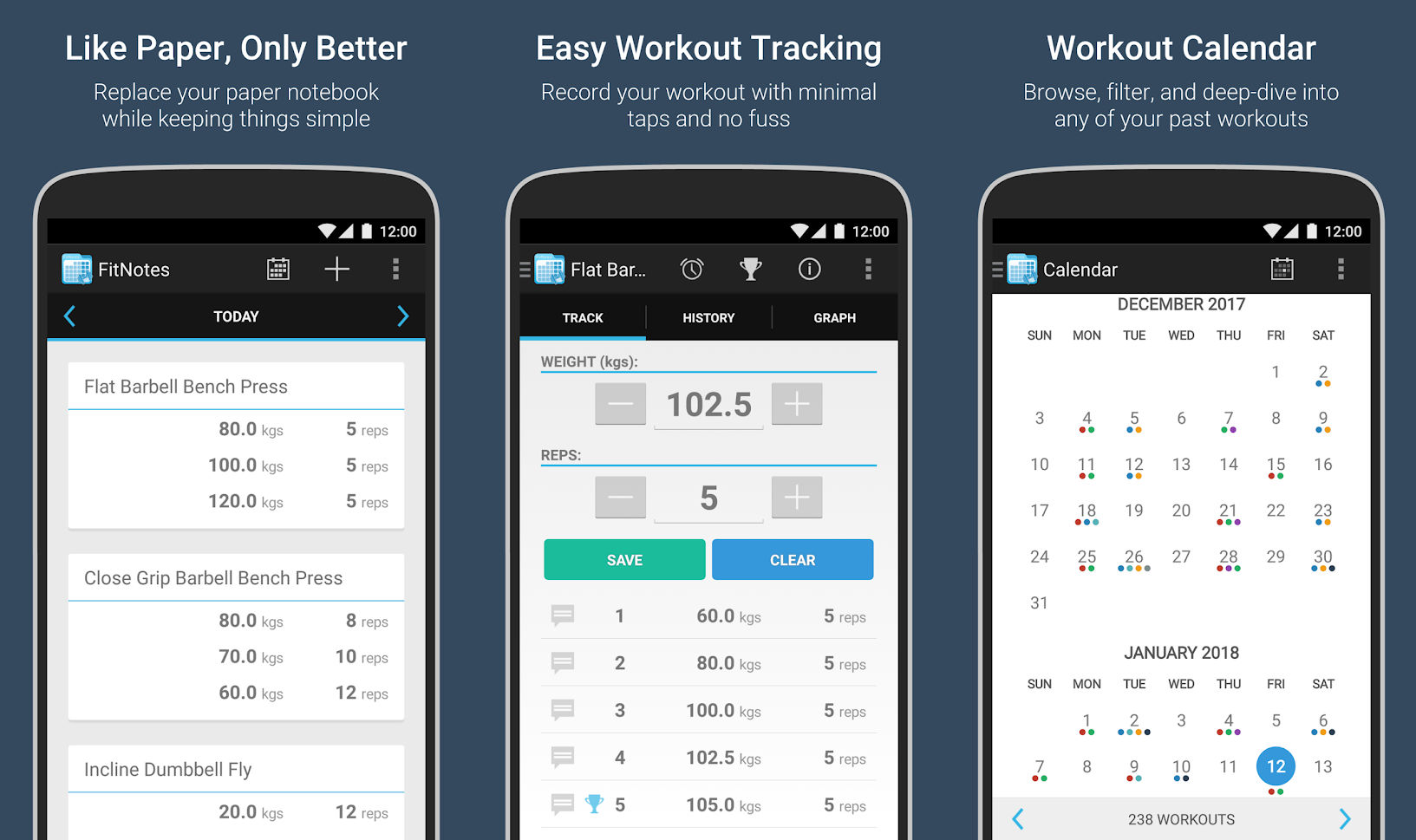
Sets and reps
A standard way of exercising each muscle is by grouping each exercise into 3 sets of 8 to 12 reps (repetitions). For example, if you bench press, you can choose a weight such that for the first set, you lift X lbs until you reach failure (can no longer lift / perform a complete cycle) after the 12th rep. Then, for the 2nd set, you do the same until your failure is maybe at the 10th rep. And for the 3rd set, you fail maybe at 8 reps.
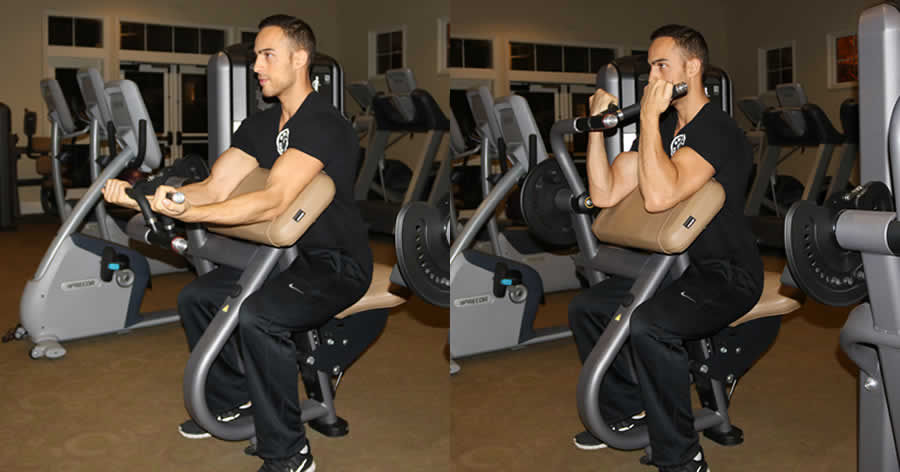
| Set | Weight | Reps |
|---|---|---|
| 1 | 100 lbs | 12 |
| 2 | 100 lbs | 10 |
| 3 | 100 lbs | 8 |
Note that more important than the number of reps is the effort to lift until failure. If, after a while, you feel that you can do more than 12 reps at X lbs for the first set, then you need to increase the weight and continue to lift until failure, regardless of the exact number of reps you can do. This is called “progressive overloading.”
Let me repeat that. Train until failure such that you can barely complete your last rep with proper form. The last 2 to 3 reps before failure are the ones that count towards building muscle.
Breathing
You might be tempted to hold your breath while you’re lifting weights. Don’t hold your breath. Instead, breathe out as you lift the weight and breathe in as you lower the weight. Lowering weights requires less exertion, which makes it an ideal time to inhale. By breathing correctly, you’ll be able to lift more and limit fainting and injury.
Muscles
Here’s a diagram of some of the more obvious muscles that you’ll want to target when lifting weights.

Exercises
There are many types of strength training exercises you can do among free weights and machines. I personally prefer using machines as they are more comfortable and help you perform exercises using proper form and reduce the chance of injury. However, some exercises produce better results when using free weights, e.g. dumbbell or barbell chest press instead of a chest press machine. Here are some of the upper body exercises I prefer.
- Machine front pull-down
- Machine preacher curl
- Machine triceps dip
- Decline crunch
- Machine seated crunch
- Maschine-assisted pull-up
- Machine pectoral fly
- Machine chest press
- Wide-grip cable row
- V-bar push down
- Wide-grip lat pull-down
Exercise Database
Fatigue
When you start a workout, your muscles will have rested and you will be able to lift the most weight for any given exercise. As you progress through your workout, you will have less strength when performing other exercises. For that reason, it’s good to be selective in the order of the exercises you perform. For example, I would do 10 or so different exercises in the following order:
| Order | Exercise | Muscles Targeted |
|---|---|---|
| 1 | V-Bar Tricep Pushdown | Triceps (Tris) |
| 2 | Dumbbell chest press (flat) | Chest |
| 3 | Dumbbell chest press (30° incline) | Upper chest |
| 4 | Hammer Strength MTS Shoulder Press | Shoulders |
| 5 | Biceps Curl Machine | Biceps (Bis) |
| 6 | Plank exercise | Abs, Core |
| 7 | Lat Pulldown | Biceps and Latissimus Dorsi (Lats) |
| 8 | Triceps Press | Shoulders and Triceps |
| 9 | Lat Row | Lats, Delts and Back |
| 10 | V-Bar Tricep Pushdown | Triceps (Tris) |
| 11 | Row Machine | Lats, Delts and Back |
| 12 | Biceps Curl Machine | Biceps (Bis) |
Each exercise, except the plank, is done with 3 sets. This sequence takes about 1.5 hours and I burn on average 500 calories.
Muscles by Volume
Many men generally want a bigger upper body. Oftentimes, they’ll focus exercises on 2 muscles: chest and biceps. However, to have a larger upper body, they may be better off targeting larger muscles. Following is a list of the 10 largest muscles in the body.
| Muscle | Location | Volume |
|---|---|---|
| Quadriceps femoris | Lower thigh | 1,420 cm3 |
| Gluteus maximus | Back of pelvis | 760 cm3 |
| Deltoid | Shoulder | 380 cm3 |
| Triceps Brachii | Back upper arm | 370 cm3 |
| Iliopsoas | Hips | 350 cm3 |
| Pectoralis major | Chest | 290 cm3 |
| Biceps femoris | Top of the thigh | 269 cm3 |
| Latissimus Dorsi | Mid back | 262 cm3 |
| Biceps Brachii | Front upper arm | 143 cm3 |
| Sartorius | Upper and inner thigh | 126 cm3 |
Muscle Gain By Weight
The longer you lift weights, the harder it becomes to grow more muscle. Following are average muscle weight gains for men and women at different stages of resistance training.
| Stage | Men | Women |
|---|---|---|
| Newbie | 1.5 lbs / month | 0.5 lbs / month |
| Intermediate | 0.5 lbs / month | 0.3 – 0.4 lbs / month |
| Advanced | 0.25 lbs / month | 0.1 – 0.2 lbs / month |
| Year of Proper Training | Potential Rate of Muscle Gain Per Year |
|---|---|
| 1 | 20-25 lbs (2 lbs / month) |
| 2 | 10-12 lbs (1 lb / month) |
| 3 | 5-6 lbs (0.5 lbs / month) |
| 4+ | 2-3 lbs (not worth calculating) |
You may have heard that muscle weighs more than fat. However, according to science, a pound of muscle and a pound of fat weigh the same. The difference between the two is density.
Rest
In order for your muscles to grow, you need to have sufficient rest. Make sure to sleep enough, e.g. 8 hours a day. Contrary to popular belief, you don’t actually build muscle while you’re lifting weights. You do need to lift weights to add mass, but training actually causes muscle breakdown.
How to Tell if You’re Gaining Muscle
- You’re Gaining Weight
Track your weight at the same time each day and plot it on a chart to see your long-term progress. - Your Clothes Fit Differently
Getting jacked will often mean your clothes start to fit differently – usually in a good way. If you’re noticing your shirts are fitting a bit tighter around your shoulders, chest, and biceps, or your pants are getting snug in the thigh and hip area, these tend to be good signs you’re gaining healthy weight. - You’re Building Strength
If you can lift heavier weights, then you are probably building muscle. Track your strength using a log and practice progressive overloading. - Your Muscles Are Looking “Swole”
Feeling puffier or bigger is normal and likely a good sign you’re growing your muscle fibers. Lifting weights increases fluids to your muscle, giving you that post-weight training pump, especially when you are just getting started with strength training. Over time, some of the water retention may diminish, but you should continue to feel bulkier. - Daily or Weekly Progress Photos
Stand in front of a mirror and take a full-body photo. Repeat and assess your visual transformation regularly. - Your Body Composition Has Changed
Ultimately, the most efficient way to measure your muscle gain progress is to assess your body composition at the beginning and end of your bulk. You can opt for an affordable and convenient at-home scale, or schedule a DXA/DEXA scan that estimates your body fat percentage within a 1.6% margin of error.
The best way to know you are gaining muscle is if you are progressively able to lift heavier weights because the only way you can lift heavier weights if you have bigger muscles.
Tracking Progress
If you use an app to keep track of your progress, you can periodically calculate your percent gains and improvements over time. Here’s an example of my actual gains.
| Exercise | Dec 26, 2021 | March 12, 2022 | % increase | Target area |
|---|---|---|---|---|
| lbs | lbs | |||
| V-bar pushdown | 50 | 72.5 | 45% | Triceps |
| Chest press machine | 70 | 120 | 71% | Chest |
| Lat pulldown machine | 90 | 130 | 44% | Back |
| Shoulder press machine | 40 | 70 | 75% | Shoulders |
| Tricep pushdown machine | 115 | 170 | 47% | Triceps |
| Bicep curl machine | 65 | 110 | 69% | Biceps |
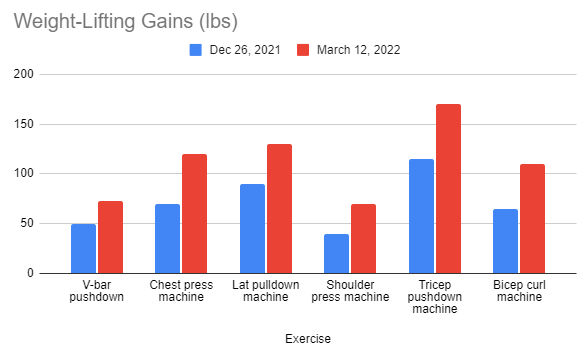
Gadgets and Accessories
To support your strength training goals, I have found the following gadgets useful.
Wi-fi body scale
I have the Withings smart wi-fi body scale. It automatically records my weight, and in the app, I can see my weight change over time.

Smartwatch
I have the Fossil Men’s Gen 6 Touchscreen Smartwatch. It’s got a ton of features.
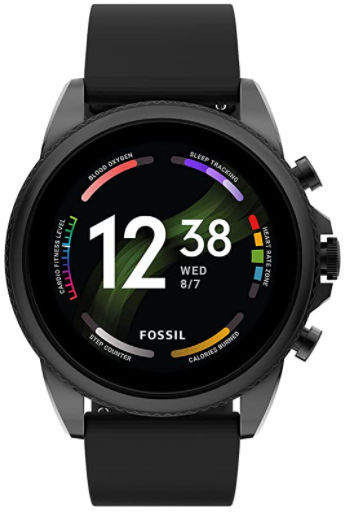
Whenever I enter the gym, I start tracking my heart rate and calories burned. When I’m done, I stop tracking. I can see a history of my calories burned and workout duration over time.
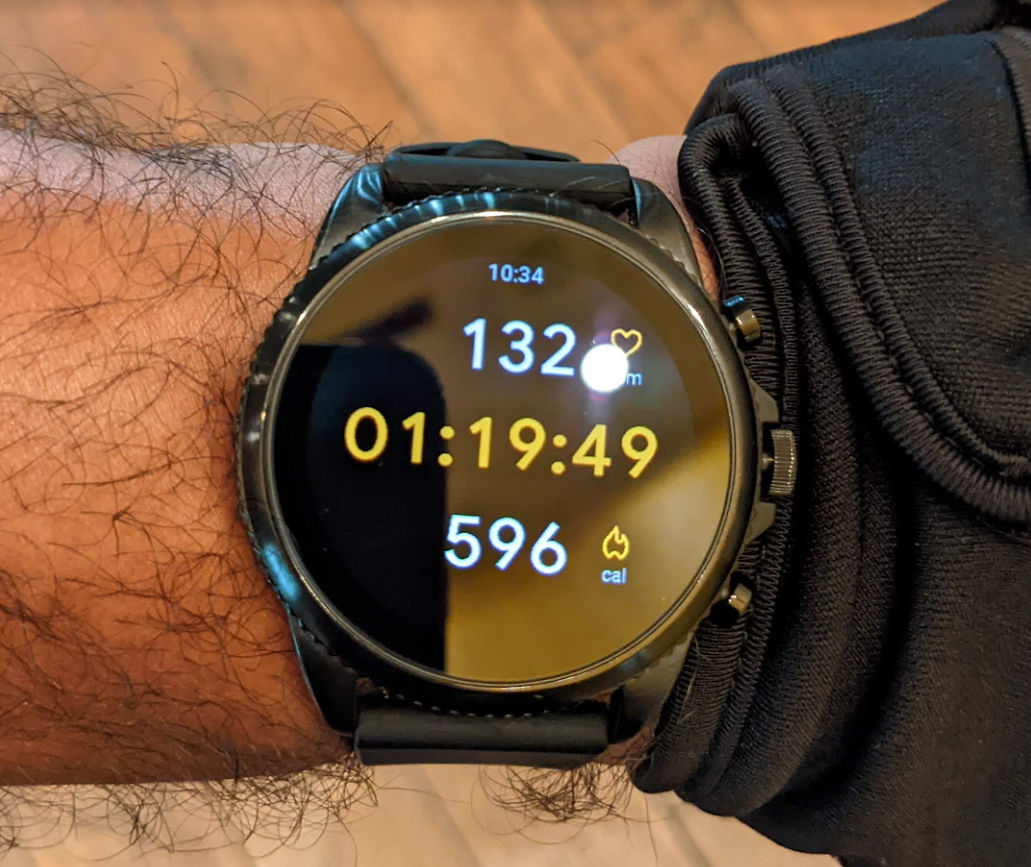
Bluetooth Headphones / Earphones
I have the Sony Wireless Behind-Neck Headset (WI-C400). Many people like to wear Beats headphones. I prefer the behind-the-neck style headset because it’s lightweight and doesn’t move around as I exercise, including when I do sit-ups.
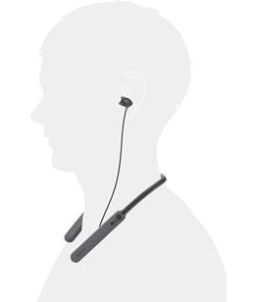
Compression T-Shirt
I have the Under Armour Men’s HeatGear Compression Short-Sleeve T-Shirt. It allows you to see your body shape so you can see how you’re progressing. I find it motivating to see physical progress.
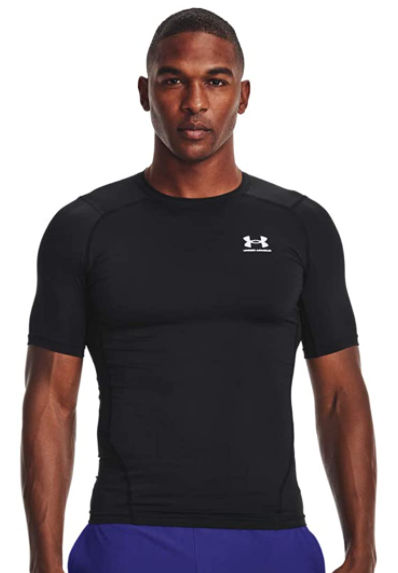
Weight Training Workout Gloves
Repeatedly lifting weights can result in calluses (thickened skin that forms as a response to repeated friction or pressure). Workout gloves tend to have a cushion to protect your skin. I find it much more comfortable to lift with gloves on.
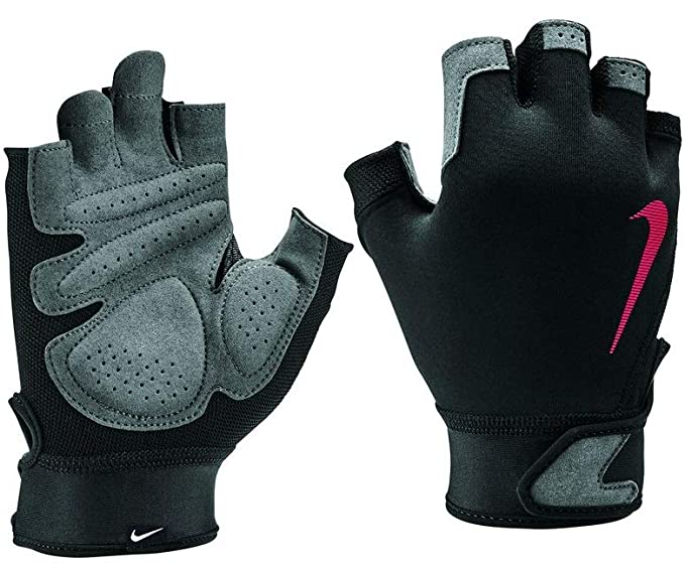
Summary
- Stay in a positive protein balance by hitting your protein consistently.
- Get your protein from high-quality sources like meat, eggs, dairy, and soy.
- Your body needs energy to grow, so you need to be in a moderate calorie surplus.
- Make sleep a priority — both quantity and quality.
- Hit the weights consistently, and train harder by adding volume (in weight, reps, and sets) over time – progressive overloading.



